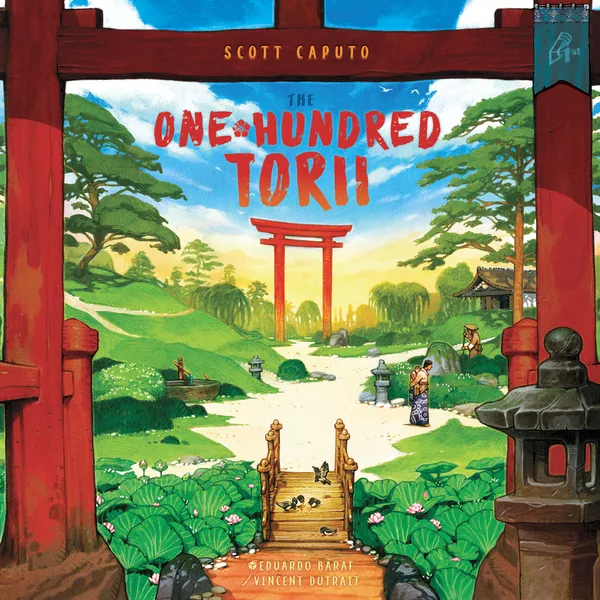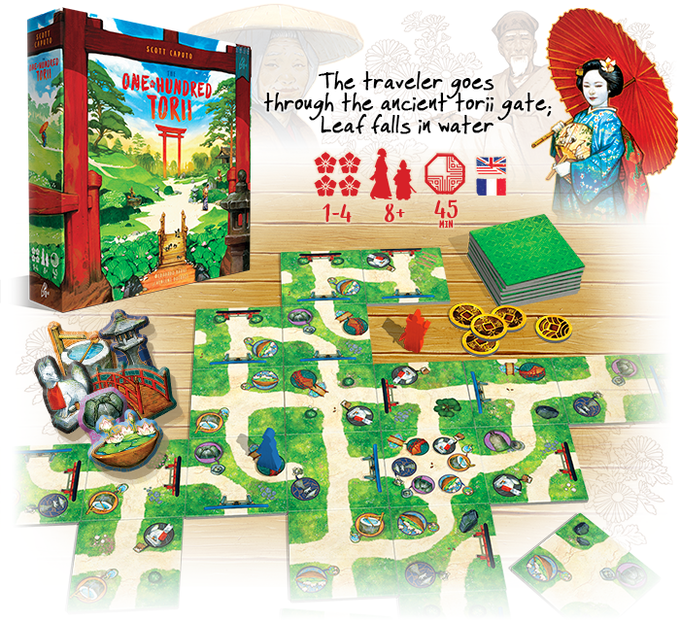Travel Through a Japanese Garden in The One Hundred Torii

Find your path through a beautiful Japanese garden as you cross bridges, travel under torii (traditional Japanese gates), seek help from poets and samurai, and build the garden itself.
Published by Pencil First Games, The One Hundred Torii is designed for 1-4 players and plays in 45-60 minutes.
Gameplay
Each player starts the game with two tiles in their hand and two gold tokens. The start tile is set in the center of the table. A tile shows a piece of the garden, it can show one or more of the six types of landmarks in the game and will show paths and dead ends.
On your turn, there are four phases. During the first phase, you may choose whether to spend tokens in order to get help from one of the five characters. Each one helps in a different way, such as the vendor, who allows you to discard one of your tiles and draw two new ones, or the samurai, who allows you to place the samurai meeple in an empty space to block another player from placing a tile there until the samurai is moved again. You may spend your gold tokens or any landmark tokens you have collected in order to get the help. Some characters cost one token while others will cost you three.
The first time you get a specific character to help you, you take that character’s point token and keep it flipped to its two-point side in front of yourself. The second time you get a specific character to help you, you flip its point token over to its four-point side. The first player to get a specific character to help him three times takes that character’s three-point achievement tile.
Next, you play one tile from your hand. A tile must be placed adjacent to another tile already in the garden, but there are no other restrictions as to which tiles may be placed next to which other tiles.
Each tile has at least one landmark on it. If you can make a line along the paths in the garden from a landmark on the tile you just played to a matching landmark, then you earn one landmark token of that type. You must follow the shortest possible path, and you earn an additional matching landmark token for each red torii that the path passes through, and one landmark token of any other type for each blue torii the path passes through.
If you ever have five matching landmark tokens, you must immediately turn them in for a matching five-point landmark tile. If you collect five matching landmark tokens and you already have that landmark point tile, you flip it over to its ten-point side. You cannot have more than one landmark point tile for each landmark type.
If, when playing a tile, you make an enclosed space that has no open paths and at least two landmarks inside it, then you take a two-point enclosure tile. Do so a second time, and you flip the tile over to its four-point side. The first player to make three such enclosures earns an additional three-point achievement tile. Additionally, the first player to earn three 10-point landmark tiles earns a five-point achievement tile, and the first player to earn a point tile for each of the landmark types also earns a five-point achievement tile.
Finally, you end your turn by drawing up to a hand size of two tiles. The game ends once all the garden tiles have been drawn and each player has had one final turn. The player with the most points from all point tiles collected wins the game.

Review
The One Hundred Torii is relatively light on rules, with a puzzle that will give you plenty to think about on your turn. From all the characters you can recruit to the various ways you can play your tiles, there are a number of options on your turn to consider, and working out the most efficient action can be tricky.
It’s quite refreshing to have a tile-laying game where the rules for placing those tiles are so streamlined and easy to teach. In general, all the rules are simple, although explaining the scoring system does take a little bit of time.
There is a nice range to the scoring system. It doesn’t feel too complex, but there’s still a nice selection of choices for what to pursue. The characters are also an interesting dynamic as you balance their skills and how you can use them to optimize your turn, while also trying to get points directly from using them.
There is plenty of player interaction, as each player’s move can so easily change the layout of the board, and you’re often racing to be the first to claim different achievement tiles. However, the gameplay does slow down as the game progresses, the board grows, and you have more paths to consider. It is quite satisfying, though, when you figure out how to pull off a particularly good move.
From the artwork to the component quality, the game is lovely, and there is something quite pleasant about a garden theme. However, it can sometimes be difficult to tell if a landmark is on a path or along a different section of the tile, and it’s easy to make mistakes with this. There are also just a lot of components for what feels like a lighter game. It is a bit overwhelming and feels as if there could have been a simpler way to track some of the information.
Overall, The One Hundred Torii is a pleasant puzzle. It doesn’t feel especially unique, but it offers a nice combination of mechanics, is quite attractive, and adjusts well across its player count.
Pros: Minimal rules for tile placement, multiple ways to score points, character help mechanism
Cons: It can be easy to make a mistake over where the landmarks are on the tiles, too many components, scoring takes some time to teach
Disclosure: we received a complimentary review copy of this game.







